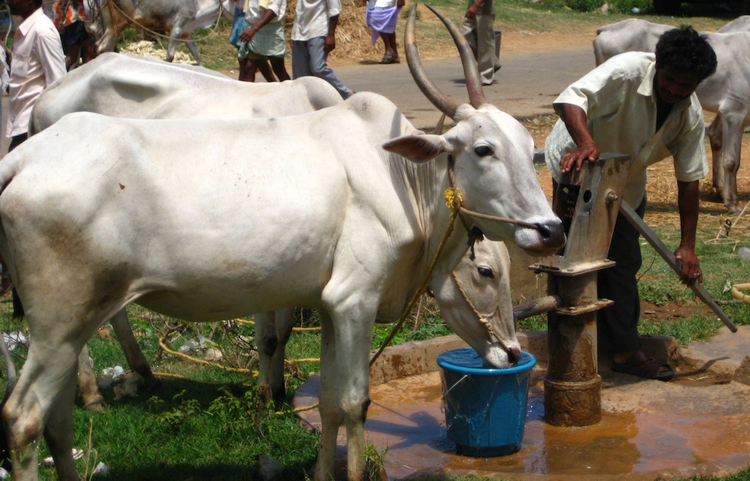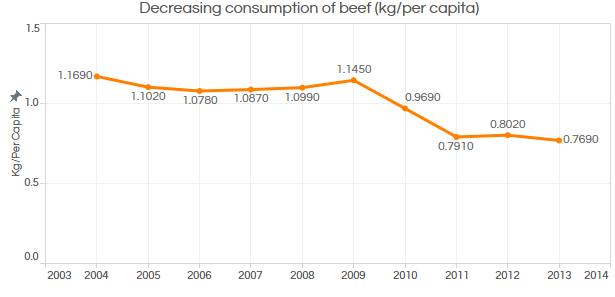Beef Eating Falls, Bovine Slaughter Grows In India

As controversy flares over a ban on not just slaughter but possession of beef--punishable with a jail term of up to five years--in Maharashtra, the data reveal that consumption of bovine meat is falling in what was, in an ancient era, a country of beef-eating Hindus.
From 1.7 kg per year (reflecting the low consumption of beef among Indians overall ) in 2004, consumption of bovine meat--primarily beef and buffalo--fell to 0.77 kg in 2013, according to this report from the Organisation for Economic Cooperation and Development (OECD) and the Food and Agriculture Organsation (FAO) of the United Nations.

Source: OECD
This could be because of the growing stigma, pushed by Hindu right-wing groups, about eating beef. This does not mean that fewer bovines are being killed. Except for a dip in 2009, the production and export of bovine meat, much of it buffalo, is rising and is projected to keep increasing.
Maharashtra is now the 25th Indian state to enact a law that bans the slaughter or sale of cows.
Among Hindus, a variety of lower castes still eat beef, alongwith most Muslims and Christians, for whom beef is a cheap source of protein, since it is cheaper than mutton or chicken.
Eating beef was once common among Hindus, as the religion's ancient texts reveal.
"In the agnadheya, which was a preparatory rite preceding all public sacrifices, a cow was required to be killed. In the asvamedha, the most important of public sacrifices, more than 600 animals and birds were killed and its finale was marked by the sacrifice of 21 cows. In the gosava, an important component of public sacrifices like the rajasuya and the vajapeya, a cow was offered to Maruts," said Dwijendra Narain Jha, a historian specialising in ancient and medieval India, during a 2012 interview, explaining--as he often has, citing various Hindu texts--how eating beef was once common.
"The killing of animals, including cattle, figures in several other yajnas as well. In the Vedic texts and the Dharmashastras, there are also references to occasions when cows were killed for consumption, and eating of beef was de rigeur. One later Vedic text unambiguously tells us that 'verily the cow is food', and another refers to the sage Yajnavalkya's stubborn insistence on eating the tender flesh of the cow," said Jha. "The reception of a guest, according to Vedic and post-Vedic normative texts, required the killing of a cow in his honour. Textual evidence also indicates that Brahmins were fed the flesh of the cow in funerary rites. I have indicated only a small portion of evidence, but ancient Indian texts provide copious references to the killing of the cow for sacrifice and sustenance."
As FactCheckIndia has previously noted, food scientist and historian, the late K T Achaya, in his book Indian Food: A Historical Companion (Oxford University Press, 2004) explains how beef and buffalo were eaten during the time of the great Brahmin poet Kapilar of the Sangam epoch (1-500 AD).
“There were 15 names for the domestic pig, and even wives of the rich traders living in the coastal regions relished pork,” Achaya writes. “The wild boar is described as being hunted using dogs and nets, a practice also for the rabbit and hare. Captured boars were fattened with rice flour and kept away from the female to improve the taste of the flesh. Even meat from an elephant either killed in battle or hunted down was dried and stored for consumption.”
More than 80% of Indian population is non-vegetarian, according to this study by the Anthropological Survey of India. In general, eating meat is a growing trend--although poultry is the primary meat of choice--as we have previously reported, accompanying rising prosperity.
India’s protein intake has risen from 54.1 gram in 2005 to 61.5 gram in 2013, according to the Food and Agriculture Organisation. The consumption of meats and poultry has risen from 1kg / per capita in 2004 to 2.5 kg / per capita and is expected to grow to 4.6 kg/per capita in 2023.
Image credit: Flickr/TechnoFreak



